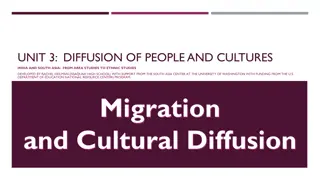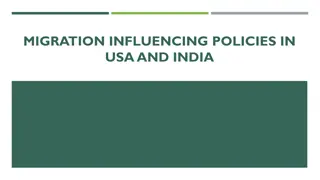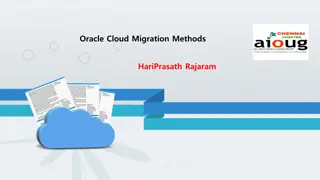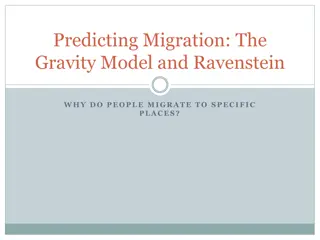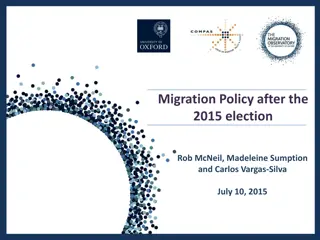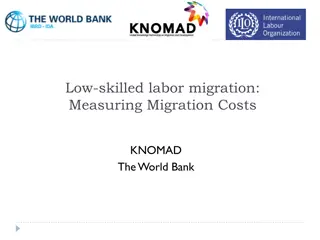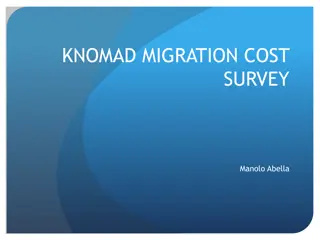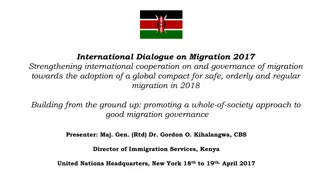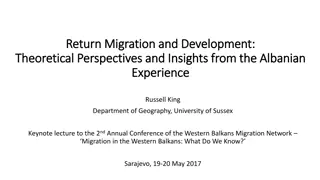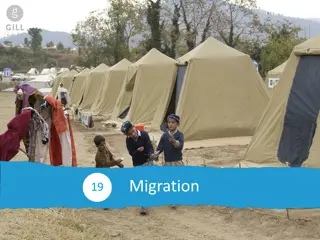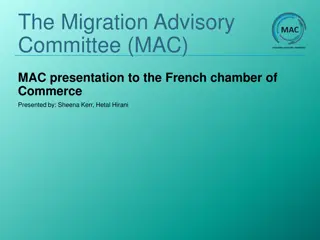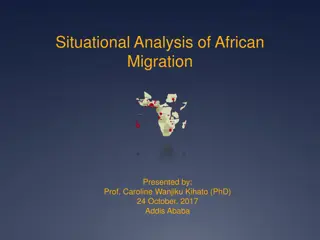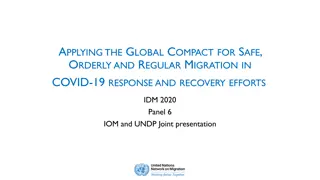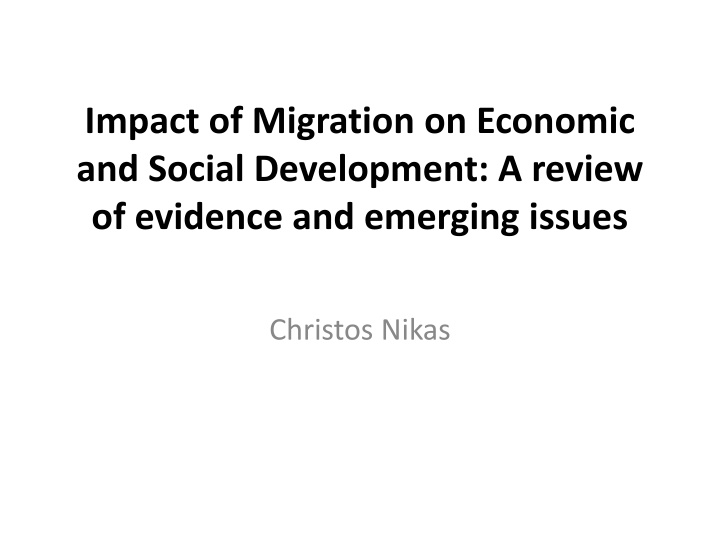
Impact of Migration on Economic and Social Development: A Review of Evidence
This review examines the economic and social implications of migration on both origin and destination countries, emphasizing the positive impacts such as remittances, increased incomes, and access to resources, while also addressing challenges like exploitation and identity shifts. The discussion encompasses the significance of managing immigration and explores emerging issues related to environment, demographics, democracy, and security.
Download Presentation

Please find below an Image/Link to download the presentation.
The content on the website is provided AS IS for your information and personal use only. It may not be sold, licensed, or shared on other websites without obtaining consent from the author. If you encounter any issues during the download, it is possible that the publisher has removed the file from their server.
You are allowed to download the files provided on this website for personal or commercial use, subject to the condition that they are used lawfully. All files are the property of their respective owners.
The content on the website is provided AS IS for your information and personal use only. It may not be sold, licensed, or shared on other websites without obtaining consent from the author.
E N D
Presentation Transcript
Impact of Migration on Economic and Social Development: A review of evidence and emerging issues Christos Nikas
1. Introduction This lecture provides a review of the literature on the development impact of migration and remittances on origin countries and on destination countries in the South. International migration has development implications for origin and destination countries in the South and in the North. Some 215 million people or 3 percent of the world s population are believed to live outside their countries of birth. While the focus in the literature has been on South-North migration, the number of migrants between developing countries is estimated to be as large as the number of migrants moving from South to North. Thus, the development implications of migration and the need to manage immigration are as relevant to the South as they are to the North. Although violent conflict, political persecution, and trafficking are important causes for international mobility, more than 9 out of 10 international migrants move for economic reasons. By and large, migration has positive economic impacts on the migrant household, the sending country as well as the receiving country.
The presentation is organized as follows. Section 2 provides a discussion of the development implications, first economic and then social impacts, of migration for origin countries. Section 3 discusses the available evidence on the impact of migration on destination countries in the South. Section 4 concludes with a brief discussion of selected emerging migration issues such as environment and climate change, fertility and demographic patterns, democratic processes, and national security, and some policy recommendations for enhancing the impact of migration on economic and social development.
2. Development implications of migration for the origin countries Migration is a decision that impacts the welfare of the household, the home community, and in the end the whole economy in various ways. The welfare implications of migration on the origin country are most often, though not always, sizable and positive. The main channels through which migration alleviates poverty are increased incomes from remittances, ability to smooth consumption, access to finance for starting a new business, as well as tapping on to the knowledge and resources provided by the international community of the migrant diaspora. Besides pure monetary gains, migration and remittances allow for higher investment in health care and education. Yet, not all impacts are positive: exploitation of migrants by unscrupulous recruiters or employers is reportedly widespread; separation from family can be stressful for migrants; and large scale immigration can pose serious challenges to a nation s identity and sovereignty.
2.1 Economic implications for the origin country A. Remittances While migration has economic, social, and cultural implications for the sending and host societies, remittances the migrants send home are perhaps the most tangible and least controversial link between migration and development. According to the official estimates, migrants from developing countries sent over $315 billion to their origin countries in 2009, three times the size of official development assistance. The true size of remittances including unrecorded flows through formal and informal channels is likely to be even higher. While remittances to developing countries declined modestly in 2009 because of the global financial crisis, these flows have remained resilient compared to private capital flows, and have become even more important as a source of external financing in many developing countries. Migration and remittances have both direct and indirect effects on the welfare of the population in the migrant sending countries.
A cross-country study of 71 developing countries found that a 10 percent increase in per capita official international remittances will lead to 3.5 percent decline in the share of people living in poverty. Evidence from Latin America, Africa, South Asia and other regions suggests that remittances reduce the depth and severity of poverty, as well as indirectly stimulate economic activity. The dramatic increase in remittances was responsible for one third to one half of the overall reduction in headcount poverty rate in Nepal from 42 percent in 1995-96 to 31 percent in 2003-04. Remittances have been found to have an income stabilizing effect at both the macroeconomic level and at the household level. Historically, remittances have tended to rise in times of economic downturns, financial crises, and natural disasters because migrants living abroad send more money to help their families back home. In Ghana, remittances were found to help households to minimize the effects of economic shocks on household welfare.
Remittance-receiving households in Ethiopia used their cash reserves and thus avoided having to sell their livestock to cope with drought. Recent evidence from Mali confirms that a substantial part of remittances is saved for unexpected events and the migrant thus serves as an insurer for the whole household. Cross-country analysis indicates that remittances are related to greater income inequality in Africa and Latin America. However, other studies suggest that migration enhances the welfare of the rural poor disproportionally, for example, in Mexico, in rural Egypt and in other regions. Migration may also raise inequality initially, as only the relatively well-off have the resources to send workers abroad and therefore receive remittances. However, as migrant networks are established in the destination countries, the cost of migration falls so that the less well-off can afford to migrate. Migrant remittances increase domestic savings as well as improve financial intermediation, prospects. which can improve growth
Evidence from Philippines, Mexico and other countries suggests that remittances increase the accumulation of assets in farm equipment, promote self-employment and increase small business investments in migrant-sending areas. Factoring the remittance inflows correctly into macroeconomic analysis is also likely to improve the credit rating and external debt-sustainability of the remittance-receiving country. Because they are a large and stable source of foreign currency, remittances are likely to curtail investor panic and prevent sudden current account reversals during a crisis. Furthermore, future flows of remittances can be used as collateral by governments and private sector entities in developing countries to raise financing in international capital market. These innovative financing mechanisms can be used to raise funds for development projects such as low- income housing, or water supply.
The diaspora serves as a link between the sending and receiving communities, expands the opportunities to access international financing, and facilitates networking. The diaspora also contribute through philanthropic remittances, and the development of their former communities through hometown associations and collective financing of development projects such as schools, health facilities and community infrastructure such as the Tres Por Uno program in Mexico. Access to information through the diaspora and the skills learned by returning migrants can improve technology, management and institutions in the sending country, and lower the fixed cost and knowledge requirements for setting up an international business. Emigrants may also be an important supply of foreign investment, as their knowledge of their home country institutions (and perhaps a greater ability to maneuver within the home country regulatory framework) may mean that they incur lower investment costs and/or higher returns, compared to other international investors.
In the current environment of a credit crunch after the financial crisis several countries have started looking at the diaspora abroad as potential sources of capital. In the past, Israel and India have raised over $35 billion of development financing by issuing diaspora bonds. For the countries, diaspora bonds represent a stable and cheap source of external finance, especially in times of financial stress. Diaspora bonds have several advantages, both for the issuer and for the emigrant who buys the bond: Through retailing at small denominations, issuers can tap into the wealth of relatively poor migrants, although diaspora bonds are not necessarily limited to migrants. Migrants are expected to be more loyal than the average investors in times of distress. And they might be especially interested in financing infrastructure, housing, health and education projects.
B. Migration and Human Capital Formation. There is a growing body of evidence suggesting that the income from remittances is disproportionally spent on education and health rather than everyday consumption. Once in school, the children of migrants may be more likely to finish their education, as the increased income from remittances provide additional financial resources and better prospects associated with migration influence social norms and incentives towards gaining more education. Evidence from rural Pakistan suggests that temporary migration is associated with higher school enrollment, especially for girls. Furthermore, migration has been observed to increase health knowledge in addition to the direct effect on wealth, which has led to lower rates of infant mortality and higher birth weights in Mexico. C. Health Related Issues Visiting and returning migrants may also bring back health-improving practices such as drinking safe water and better sanitation.
On the other hand, migration as such might also present a threat to migrant health as certain jobs expose migrants to occupational hazards, such as tuberculosis, pneumoconiosis and workplace injury by mine workers. Increased mobility of workers has also contributed to a rapid spread of communicable diseases such as HIV It has been estimated that find that 27 percent of the male. Senegalese migrants were HIV positive compared to 1 percent for non-migrants males from the same area. Sexually transmitted infections are also more likely to spread among migrants themselves as well as their permanent partners residing in the sending communities. D. The Brain Drain Issue High-skilled emigration or the so-called brain drain can imply a loss of public resources invested in their education, can reduce the sending country s productive capacity, and can worsen the business environment, especially in small economies.
The emigration of the highly skilled can be particularly important in the education and health sectors in small countries that face severe shortages of health workers. Moreover, the departure of doctors may result in underemployment of nurses and other auxiliary staff. The case of Greece in recent years is indicative However, it has been argued that, return migration can lead to mitigation of the brain drain, if not a net brain gain. When the migrants return, they have usually acquired skills that are needed in the sending community as manifested by a sizable wage- premium paid to the returned migrants. Furthermore, some authors suggest that the possibility of emigrating abroad increases the interest in and returns to higher education, which can increase the total number of highly skilled also in the home country. Despite concerns about the detrimental effects of brain drain on health, the shortage of health professionals in Africa is likely to stem from causes entirely unrelated to international migration such as fragmented labor markets and insufficient public financing.
E. Remittances and Economic Growth Evidence on the relationship between remittance inflows and economic growth in migrant sending countries remains inconclusive. Empirical studies have found little evidence in support of a positive impact of remittances on economic growth. In general, studies focusing on the labor supply response of the remittance-recipient households tend to find that remittances lower work efforts and hence reduce long-term growth. Other studies find that remittances improve financial access and financial development and therefore stimulate growth. Furthermore, the merit of remittance flows might lie more on increasing the level of income for the poor rather than the growth of the economy as a whole. Evidence from Latin America and Cape Verde suggests that remittances can lead to exchange rate appreciation, which can reduce the competitiveness of the tradable sector, the so-called Dutch Disease.
The emigration of the highly skilled can be particularly important in the education and health sectors in small countries that face severe shortages of health workers. Moreover, the departure of doctors may result in underemployment of nurses and other auxiliary staff. However, remittances are less likely than natural resource windfalls to result in persistent exchange rate misalignment, while the exchange rate implications of relatively stable remittance flows are likely to be easier to manage than a comparatively abrupt shock due to a natural resource windfall. In general, the inconclusive results on the impact of remittances and growth are largely due to the difficulty of separating the cause from the effect: if remittances react counter-cyclically to growth, then the negative relationship between the two is a result of reverse causality running from growth to remittances, not vice versa.
2.2 Social impacts on the origin country At its best, migration can be a rewarding experience that is made in the interest of the household welfare, but in most cases moving to another country and being separated from one s immediate family takes place at considerable emotional cost. Especially temporary circular migration increases the risk for family breakdown, fragmentation of social networks and psychosocial stress. The emotional impact is not just limited to the migrants themselves, but also to the family left behind. Especially in poorer households where the whole family cannot afford to emigrate together, they emigrate one member at a time resulting in eroded family structures and relationships. The longer the separation between the migrating parents and their children, the more children lose parents reference in the management of the household, their authority and their role as providers of love and material care. Parents are gradually replaced by other family members, or the children take upon themselves the task of parenting.
The feelings of rejection, abandonment and loss follow the children left behind, and cannot be compensated by the material gifts and remittances sent from abroad. To some extent the recent technological advances in terms of e-mail and affordable telephone calls might allow the transnational families to form and foster social ties even at a distance. Separation from the parents has also long-term consequences in all aspects of the children s lives. Evidence from Mexico points to the fact that the offspring from migrant families have lower educational attainment than other children, as the boys of the migrants are more likely to opt for migration themselves (implying decreasing returns to education) while the domestic workload of the daughters increase. Adolescents left behind are also commonly overrepresented in adapting risky behavior, and absence of mothers has been found to be associated with the involvement of children with violence:
80 percent of children in conflict with the law in Jamaica had their mothers absent, while this was the case for only 30 percent of other children. Also the abuse of drugs and alcohol as well as reduced school attendance has been observed among children left behind by migrants. On the other hand, recent evidence from Mozambique suggests that migration could also strengthen social networks as the higher income from remittances reduces the cost for the migrant- sending household to participate in these networks. This closer inter- family collaboration can, to some extent, remedy the absence of within-family cohesion and safety nets. Even though migration is usually a voluntary and planned choice of the individual, the reality might turn out to be very different from the original expectations. Too often the intended aspirations of the migrants do not materialize but many are trapped in trafficking.
Young women are exploited as sex workers abroad, and in many cases they have been promised legitimate work at the destination but then forced into prostitution upon arrival. Also children are commonly victims of trafficking that can lead to life-long trauma. The abuse of migrants by the middle men or the recruitment agencies is a problem that is growing in magnitude as the migration flows increase and the phenomenon becomes more commercialized. The problem expands from pure trafficking into working in slave- like conditions as the international market for labor allows for trading with workers contracts leading to abuse of individual migrants. The abuse of the migrant workers has lead to calls for further regulation of the recruitment agencies across migration corridors.
3. Impact of migration on destination countries in the South Unlike commonly believed, around half of the official international migration from the South is to other developing countries rather than wealthier countries in the North and official statistics likely underreport South-South migration, especially between contiguous countries because of lack of border controls; almost 80 percent of the South-South migration is estimated to take place between countries with contiguous borders.
3.1 Economic implications in the destination country Even though the channels transmitting welfare impacts of migration on the destination countries are well known in the literature, there is very limited amount of empirical evidence from the South quantifying the impacts. A brief overview of the evidence from the North is presented in box 1. Migration of people, just as international trade, benefits both the sending country and the receiving country. The welfare gain for the destination country is due to the fact that immigration increases the supply of labor, which increases employment, production and thus GDP. Immigration has also been found to increase the productivity of the receiving economies through the contribution of migrants to innovation (see box 1 and diagram 1). Another way in which immigration increases productivity is that immigrants free up the local workforce to move to higher productivity occupations.
Box 1: Global gains from migration Even though quantitative estimates of the direct gains from migration are difficult to obtain, economic simulations suggest that an increase in South-North migration would produce substantial income gains in the long-run; these income gains could exceed those from comprehensive trade liberalization; and the destination countries in the North would capture one fifth the overall benefits of increased immigration. Documented welfare gains from South-North migration work primarily though the increase in the available labor force. It has been found that immigration increases employment in the destination countries in the North one for one, implying no crowding out of natives. This result implies that immigration increases the total GDP of the receiving country without affecting average wages or labor productivity. Immigration has also been observed to boost productivity through innovation and specialization. Data from the United States show that one percent increase in the share of migrant university graduates increase the number of patent applications and grants issued per capita.
However, burdensome regulatory requirements and procedures that foreign doctors, engineers, architects and accountants have to meet in order to practice in the destination country can impose significant financial and other costs on these highly skilled immigrants. Also the less-educated immigrants increase labor productivity as they complement the uneducated local labor force that, based on their knowledge of the local language and institutions, will be better able to specialize in more productive complementary tasks. ealth care, however, the destination countries in South might face an increased burden. Irregular migrants in the South may have health needs that often remain unaddressed. Furthermore, immigrants are often willing to do jobs that locals no longer are interested in, such as care for the elderly. Also, the availability of low-cost childcare by the immigrants can enable young local women to go back to work thus boosting economic development further.
In the developing countries the welfare benefits might not be as numerous, and neither is the tax contribution of mostly undocumented immigrants likely to be substantial, but the migrants value added to the production and economic growth is still a net gain for the country. Whether positive or negative, the net fiscal impacts of immigration are not likely to be large. When it comes to the provision of health care, however, the destination countries in South might face an increased burden. Irregular migrants in the South may have health needs that often remain unaddressed.
Despite the benefits of immigration, public and the policymakers at the destination country usually believe that immigration can become an economic burden, as immigration is feared to lead to loss of jobs, heavy burden on public services, social tension and increased criminality despite the evidence to the contrary. The main channels for negative economic outcome for the destination countries are increased job competition that allegedly brings down the wages for the locals, and the increased fiscal burden for caring for a growing population of immigrants. Incoming migrants need to be integrated into the labor force, which intensifies the competition for existing jobs. Especially in times of economic downturn, the general public and the policymakers tend to become more worried about the potential adverse impact of immigration on natives opportunities, and immigrants can be used as scapegoats to blame for rising unemployment even though no strong evidence exists to show that immigrants take natives jobs.
A common worry is also a downward pressure on salaries caused by an influx of migrant workers. Still, in the OECD countries the aggregate effect of immigration on wages has been found to be very small both in the short run and in the long run, and similar findings in the context of South-South migration has been confirmed. (See Appendix) Simulations from a general equilibrium model suggest that reducing migration will not necessarily result in higher wages for native workers in receiving countries, since lower levels of migration will also lower the relative return to capital, which in turn will put downward pressure on wages. The fiscal impact of immigration depends on the costs and contributions of the immigrant population to the welfare system of the host country.
How extensive the social safety nets and welfare services are and to what extent migrants are allowed to access the domestic welfare system determines the cost on the host society, while their role as taxpayers determine their contributions to the system. The US Congressional Budget Office estimated that comprehensive immigration reform including legalization of undocumented immigrants, if undertaken, would increase federal revenues to a similar extent as the increase in federal spending on social security, healthcare and other benefits for the immigrants. In the UK, already the first-generation migrants were found to do well economically and to make a net fiscal contribution. However, the limited fiscal implication of immigrants may also be due to the fact that many of them are not eligible for most benefits, and will thus need to.
3.2 Social impacts on the destination countries in the South Apart from the increased competition at the labor markets, increasing inflows of migrants impose an integration challenge in all areas of social life. In many of the developing countries, however, policies to manage immigration are lacking while control of the same is failing to curtain the inflow of migrants due to scarce resources, weak administrative capacity, and porous borders. Some of the cross- border migration is often widely accepted, but sometimes immigrants even from neighboring countries are treated as unwanted foreigners. This inability to control migration and to integrate the newcomers has at times led to dramatic actions and great human suffering. When the economy is already under pressure, failure of integration has sometimes led to massive expulsions of migrants mostly in the South. The Nigerian Government, for instance, expelled over 2 million immigrants mainly from Ghana in 1983 due to a domestic economic crisis, for which the aliens became scapegoats.
More recent examples of forced repatriation can be found both in the North as well as in the South: the United States deported more than 350,000 immigrants and South Africa 300,000 in 2008 alone. The case of Cote d Ivoire, where striping of immigrants of some of their rights sparked a chaos that has led the once stable country to the verge of an internal conflict, illustrates the growing intolerance to foreigners in the South. These instances highlight the importance of strengthening migration and integration policies in developing countries as they host large numbers of immigrants. The challenge of integration is most prominent in urban areas. Most internal as well as international migrants end up in the cities of developing countries because of employment opportunities, with many working in the informal sector of business, transport, crafts and services. For example, a quarter of the population of Libreville in Gabon is from another country from Central Africa and West Africa. Sometime the movement is driven by the falling living standards and weak support services in the source community.
If the excess supply of labor is combined with poor ability of the local authorities to manage immigration, the result is commonly increased disparities and expansion of slum areas in the cities. Forced migration can also contribute to urbanization. War, environmental degradation, and economic crisis lead to large population movements from rural areas into cities where people take refuge. There are allegedly 2 million Somalis in Mogadishu, mostly refugees escaping the fighting in their villages and seeking protection of the NGOs or the warlords. The rapid expansion of cities combined with weak local administration or lack of migration policies have led to desperate actions by the host countries officials. Migration is only a part of the urbanization challenge, but the interaction between migration and rapid urbanization is likely to be important for policy in the destination countries in the South.
4. Conclusion Before presenting the policy recommendations, it would be useful to point out a few emerging themes in the literature and public debates on the impact of migration on climate change, political institutions, fertility and national security. The Intergovernmental Panel on Climate Change (IPCC) noted already in 1990 that the greatest single impact of climate change could be on migration. It predicted that as many as 200 million people may be forced to migrate by 2050 because of climate change. Authors estimate that rising sea levels, tidal waves and storm surges could displace millions of people in Bangladesh, some of whom might seek refuge in neighboring countries. The effects of migration on climate change, on the other hand, are less understood. It is generally assumed, that short term and circular migrants make little investment in maintaining the ecological stability of their destination while long-term immigrants have an incentive to invest in environmental management.
When migration is induced by a conflict or a natural disaster leading to a sudden inflow of migrants, the displaced people may resort to unsustainable activities in absence of other means of survival exacerbating existing environmental problems and creating new ones. Large refugee camps have especially been observed to put pressure on the ecosystem. Some authors argue that even long-term migration can affect the environment through increased competition for limited resources. On the other hand, migration can work as a channel for adoption of new techniques and raw materials, leading to more environmentally friendly production and consumption practices. Migration can have important implications for domestic institutions and politics. The emigration of capable people may cause loss of governance capacity in countries where institutions are already weak. Also, emigration can serve as a way to release political pressure, which diminishes the incentives of the established political elite to reform, increases corruption, and reduces overall government effectiveness.
Some observers have suggested that dependence on migration can create a remittance-based development model where remittances become increasingly critical for maintaining socioeconomic stability in the migrant-sending country. Migrants may also serve as a channel for democratic attitudes and behaviors absorbed in host countries to spread in their countries of origin, via visits, migrant returns, and cross-border communication, which can improve accountability. Migration also shapes values and attitudes towards gender roles within the household. When women move their role as caregivers changes, and men have been found to be more likely to engage in reproductive activities such as caring for the children and the elderly. When the men emigrate, women are empowered to take more prominent part of the community decision making, control their own income, and expand their role in the domestic sphere. Even other domestic norms, such as greater emphasis on girls schooling, higher age of marriage, can filter from the destination country to the sending society.
Migration decision is also an integral part of family planning decisions and lead to differences in fertility rates among migrants and non-migrants. Studies find migrants fertility to resemble more closely that of natives at destination, either due to social adaptation or self-selection of migrants by fertility preferences, although there can be regional variations. Forced migration due to conflicts, persecution, or sudden impoverishment may lead to international migration across borders even while large migrant groups end up being internally displaced refugees in their own country. For internally displaced population, the hostility across the different groupings in the country causes tension for regions hosting refugees, while the international refugee camps involve the possibility of international conflict. When the size of a refugee population increases over time, which is not uncommon as conflicts escalate, host communities are often overwhelmed and feel that their resources are threatened. If, on the other hand, the refugees are allowed to and are able to find jobs and send home remittances, these could also be a valuable resource for reconstruction.
There are also wider security concerns suggesting that migrants would be disproportionately involved in criminal activity than natives, even though data to support such a claim is lacking. Providing support mechanisms for youth at risk, and ensuring proper integration of the migrants will be ways to diminish the risk of violence and manage the development impact of migration. Although most remittances sent by migrants are legitimate transfers, the continued existence and use of informal channels has raised concerns of money laundering, terrorist financing and financial crimes leading to heavy regulation of providers of remittance services. The need for such alternative channels arise from the sustained high cost of remitting through formal financial institutions, cumbersome legislation related to money transfers, and mistrust of the migrants towards the financial institutions. Informality is particularly prevalent in the South-South remittance corridors.
Migration does not only imply movement of people, but also movement of cultures. Successful assimilation to the destination country requires the migrants to interact with the new society, while keeping the culture of the origin country alive creates a positive environment for the multicultural identity to form. On the other hand, some migrants may resort to the customs of the origin country more rigorously as they would have done back home. This highlights the importance of integration of the immigrants, and supporting them in the creation and formation of their new multicultural identity. Selected policy suggestions There is a vast literature discussing policy recommendations that nurture the benefits and mitigate the negative effects of migration. Before concluding, we briefly summarize a few selected policy suggestions such as integrating migration and development policies (both in South and North), facilitating the flow on remittances, improving recruitment practices, and facilitating international labor mobility.
Migration should be incorporated both in the development cooperation strategies in the North, as well as in the national poverty reduction strategies in the South. Although as of yet rare in practice, there are some cases of successful strategies for cooperative efforts between the sending and the receiving countries to manage migration. Areas of cooperation include the drivers of migration in the source country, networks that move people across borders, and integrating the legal migrants into their destination countries. While many developing countries have large stocks of immigrants, very few of them have explicit policies on how to deal with immigration or the capacity to manage their borders effectively.
Similarly to the destination countries in the North, there are calls in developing countries to focus on attracting the highly skilled migrants, discourage irregular migration, and reports of growing xenophobia. Empowering the sending and receiving countries in the South to manage international mobility will benefit the migrants, the host societies and the country of origin. Statistics on migration and remittances are often of poor quality, especially in developing countries. Few statistics measure migration flows and data are even scarcer when it comes to transit, circular, or irregular migration. Official estimates of remittance flows are usually gross underestimates of the true volumes, since a large portion of remittances are sent through unofficial channels. Improving data collection can facilitate better policies to enhance migration for development. The development community can further leverage remittance flows for development by making them cheaper, safer and more productive for both the sending and the receiving countries.
An International Remittances Agenda would involve: (1) monitoring, analysis and projections; (2) improving retail payment systems through use of better technologies and appropriate regulatory changes; (3) linking remittances to financial access at the household level; and (4) leveraging remittances for capital market access at the institutional or macro levels. As the labor market becomes increasingly global, the educational policies in developing countries will need to be revised to invest in skills that are needed within the country as well as in the global labor markets. On the other hand, the race for talent has led some destination country institutions to actively engage in recruitment of highly educated migrants, such as doctors. However, attempts to regulate skilled-worker mobility, or so-called ethical recruitment policies, does little to address the underlying causes of emigration decisions, and often leads to unintended adverse consequences.
The freedom of mobility should thus be allowed for all skill-levels, while complementary measures can be developed to foster service provision and skill development in source country. Recruitment companies account often for the majority of the cost of migrating, especially when it comes to low-skilled migrants that can leave the migrant in debt, lower wages than promised, long hours and unsafe working conditions. Facilitating migration through safe and legal channels through better monitoring of recruitment processes and bilateral coordination will help to protect the rights of the migrants and fight exploitation and trafficking. Providing knowledge about the migration process and language of the destination country will also enhance integration and quicker adjustment of migrants to the new labor market. Migrants, especially those in an undocumented or irregular situation, are likely to face discrimination, exclusion, exploitation and abuse at all stages of the migration process. Female migrants and children often face greater risks, including of trafficking and being deprived of education and access to healthcare.
Protecting the human rights of migrants is part of the obligations of the State to respect the internationally guaranteed rights of all persons, to protect those rights against abuses, and to fulfill the rights necessary for them to enjoy a life of dignity and security. Immigration and border control policies need to recognize that migration is primarily an economic phenomenon. Evidence from the US-Mexico border suggests that increasing the number of border control agents increases smuggler s fees, but is unlikely to curtail the number of migrants as intended. Instead, providing legal channels for temporary migration when the labor is in high demand in the destination country is more likely to enhance the benefits of migration for all parties.


